18泊の日高全山縦走でのイグルーは4泊。あとは?
前回紹介した先週の北大山岳部OB中川凌祐さんの全山縦走山行でイグルー泊は3ヶ所4泊でした。中川さんはイグルー作りは慣れていて、すぐに作ってしまいます。なのになぜテントを持って行ったのか訊いたところ、丁寧にこたえてくれました。
①イグルーでは濡れが乾かない
イグルーだと製作時にウェアが濡れ、寝てる時に吹き込みによりシュラフカバー等装備がどうしても少し濡れてしまいます。長期戦を考えると濡れものは重くなるし不快なのでそれらをしっかり乾かしてから進みたいのですが、冷えにくいけど暖まりにくいイグルーだとストーブを炊いても乾きにくく、ガスが勿体無いと考えました。テントの場合濡れは行動中に生じるもののみで、ウェアは炊事しながらの着干し、グローブやソックスは上に洗濯バサミで吊るしておけばほぼ乾きました。
確かにそのとおりです。イグルーは、ストーブをたいてもテント内が暖まるようにはなりません。吹き込む粉雪も、不評です。この「濡れ」をどう受け入れるかですね。
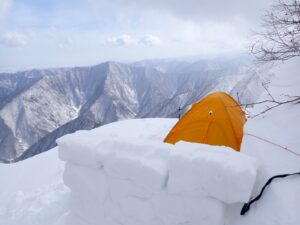
八の沢右岸尾根Co1700mのC6=C7 強風帯なので支尾根に下ろして風を避けた。巨大ブロックの風よけは必要 Descended to a wind-sheltered spur due to strong winds at altitude 1700 meters on the right bank of Hachino-sawa = C6 = C7, as it is a strong wind zone. A large block is necessary for wind protection.
②風の弱い支尾根に降りてテントを張る選択肢
悪天や緊急時に風下の支尾根に逃げ込んでテントを張るという選択肢を持っておきたかったという点です。実際降ろすかどうかは別にして、そのような状況下で様々な選択肢を持っておくのは単独行において精神的に良いと感じました。今回、C6=C7,C9はそのような使い方でした。支尾根に下ろしてイグルーよりテントを使うのは1つ目の理由が大きいです。
選択肢を多くするため。これもわかります。
③キツい行程の最後にイグルー作るのが辛いときもある
30kg以上の荷を背負い10時間を超えるような行動をした後イグルーを作るというのを連日やるのは身体的に厳しい気がしたからです。特に腰が怖いです。勝亦さん*も全山の際、腰を痛めイグルー製作を断念した日があったようです。
重いブロックを扱う作業です。たしかに重心の配り方を誤ると痛くなります。私も講習会で一日に5つも6つも作って見せるときなどは腰に不安を感じます。単独の長期山行ならではのリスク想定です。*北大山岳部で2015年に日高全山縦走をした勝亦浩希
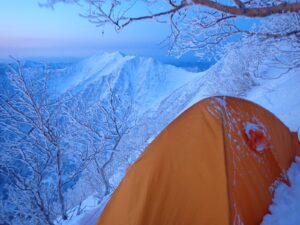
ルベツネ山手前1688南東尾根頭C10。12.5時間行動の後氷混じりの雪面を開削して無理矢理止まる。イグルー作るのはしんどい時もあるC10 on the southeastern ridge head of Mt. Rubetsune. After 12.5 hours of activity, he struggled to clear the snow surface mixed with ice and had to set up a tent.Sometimes it can be tough to make an igloo after a hard days end
重さ・雪壁作り・朝のテント撤収のデメリット
それらのメリットとデメリットを天秤にかけて最終的にテントを持っていく判断をしました。再挑戦を考え始めたのは昨年の8月くらいだったと思いますが、そのタイミングでテントを持っていくのは決めてました。なので多少重くなっても背負える身体を作り、入山したら朝はイグルーの時より睡眠時間を少し削って解決しました。
また、去年の事故以降、地形をより大きく把握する癖を付け、気圧配置と近くの沢の向きや沢の大きさから海からの風がそこにどのくらい集まるかをイメージしてテンバを選びました。これはイグルーでもテントでも大事ですね。
イグルーといえども強風の場所では徐々に壁が削られます。特に強風のために積雪が無いくらいハイマツや地面が近くに見えているような所は、今はイグルーを作れる積雪があっても多少風向きが変わると、雪が削り取られる可能性があります。
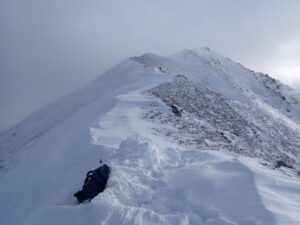
カムエク北のコルでΩ5、強風エリアで背後は雪が飛ばされ露地が見えている Ω5 at the northern col near Kamuiekuuchikaushi, a strong wind area.
強風地帯の3ヶ所はイグルーが頼りだった
去年はイグルーが目的になってしまっていた感が否めませんでしたが、今年は前進のための武器として使えたと考えてます。今回イグルーを採用したタイミングは、吹きさらしで強風地帯のカムエク手前、ナナシの吹上の1823峰、2つ玉低気圧襲来で停滞した神威手前でしたが、どれもイグルーを作る労力を費やす価値のある局面だったと思います。
暴風雪でのテント泊はブロック壁で風を防いでもテントへの雪の吹きだまりは避けられず、積雪で押しつぶされないよう夜中でも除雪しなければなりません。イグルーはこの点が非常に優れています。中川さんはイグルー経験を自信にして、この強風帯を進めることができたといいます。
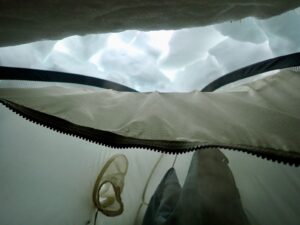
神威岳手前のコルでイグルー+テントのハイブリット型Ω12,13。快適に2泊 Ω12, 13, a hybrid type of igloo and tent at the col near Mt.Kamuidake. Comfortable for 2 nights.
イグルー+テント
イグルー内テントうまくいきました。動機はせっかくテント持っているしイグルーと組み合わせて双方のメリットを組み合わせた快適空間で停滞し身体を休めたかったからです。結果としてテントは一切風に煽られず、内部はポカポカ、ちょっと入ってくる吹き込みはテント膜が遮断という思い描いた通りになりました。黒部横断で雪洞テントがよくやられるそうですが、それやるならイグルーテントの方が積雪少なくても可、短時間で作れる、生き埋めや酸欠の心配は少ないといったように有効なんじゃないかと思いました。
イグルスキーも初期の頃、イグルー+テントやりました。4人用エスパースだったので、巨大イグルーになりました。いまは、テント持って行くほどの動機がないのでやっていませんが、確かにテントを持って行っているのならハイブリットで最強です。
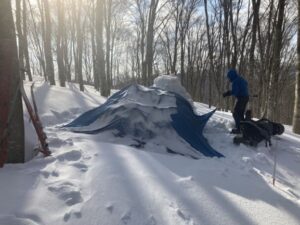
昨年の奥美濃県境山行でのイグルー+タープ Igloo + tarp used during last year’s mountain expedition near the border of Okumino Prefecture.
イグルー+外からタープ
イグルスキーが最近やるのは、タープをイグルーの外側にかぶせて、四隅の紐をピッケルやストックやハイマツに縛って固定する方法です。隙間からの吹き込みが無く、気温の特に低い夜は暖かく過ごせます。
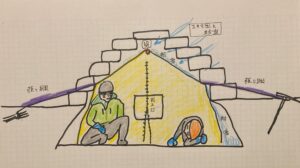
ブロックの隙間から張り綱を出して、外で固定する。ツエルトの出入り口とイグルーの出入り口を合わせる。By putting up guy lines from the blocks and securing them outside. Aligning the entrances of the tarptent and the igloo.
イグルー+内側にツエルト(tarp tent)
イグルー内にツエルトを張る方法を考えました。ツエルトは必携品だから、憶えておきましょう。8割ほどイグルーを作ったら、ストックを、ツエルトのベンチレーターに通した後、ストック2本をバンドなどで2ヶ所で縛り、長い梁を作ります。梁を、イグルーの入り口方向に向けて壁にかけ、残りの屋根を塞ぎます。前後の張り綱はストックに沿って外に出しておきます。梁があるから、屋根も塞ぎやすくなります。イグルーが完成したら、中でツエルトを広げ、梁綱をブロックの隙間から外に出して、周りの雪の中にハイマツの枝などに絡めて埋めて固定します。ツエルトの側面の梁綱も、ブロックの隙間から外に出して張ります。こうすると、イグルー内ツエルトが張れて、ストーブを焚けば暖かく、隙間からの吹き込みも防げるハイブリッドイグルーができます。
Combining igloo with tarp, tent, and tarp tent.
In an 18-night traverse of the Hidaka Mountain Range, igloo camping was done for 4 nights. What about the rest?
In the recent traverse of the entire Hidaka Mountain Range by Nakagawa Ryosuke, an alumnus of the Hokkaido University Mountaineering Club(AACH), igloo camping was done at 3 locations for a total of 4 nights. He is experienced in building igloos and can set them up quickly. When asked why he also brought a tent, he politely provided an answer.
1. Inability to dry wet items inside igloos
With igloos, clothing gets wet during construction, and during sleep, blowing snow inevitably causes gear like sleeping bag covers to become slightly damp. Thinking about long-term outings, wet items become heavy and uncomfortable, so I wanted to ensure they were dried properly before moving on. However, igloos, although resistant to cold, are not easily warmed even with a stove, making drying difficult, and I considered it a waste of gas. With tents, wetness only occurs during activities, and clothing can be dried while cooking, gloves and socks can be hung with clothespins, and they dry out almost completely.
Indeed, that’s correct. Even with a stove, igloos don’t warm up as efficiently. Blowing snow, too, is not appreciated. It’s about how one accepts this “wetness.”
2. Option to descend slightly to the lee side of the ridge, away from the wind-protected spur.
I wanted to have the option of seeking refuge on a wind-protected spur in case of bad weather or emergencies and pitching a tent there. Actually setting it up or not is another matter, but I felt that having various options in such situations is mentally beneficial for solo trips. This time, C6=C7, C9 were used in this way. The primary reason for using a tent instead of an igloo on a wind-protected spur is significant.
To increase options. I understand that too.
3. Sometimes it’s tough to build an igloo at the end of a tough trek
I felt that building an igloo after carrying over 30kg for more than 10 hours of activity is physically demanding, especially worrying about my lower back. Mr. katumata* also injured his back during the entire mountain traverse and had to abandon making igloos for a day.
It’s a task handling heavy blocks. Indeed, if you misplace your center of gravity, it can be painful. I also feel anxious about my back when demonstrating making five or six igloos in a day during training sessions. It’s risk assessment unique to solo long-term mountain trips.
*Katsumata Hiroki(AACH), who did the entire Hidaka Range in 2015.
The disadvantages of weight, snow wall construction, and morning tent dismantling
I weighed the pros and cons and ultimately decided to bring a tent. I started considering a rematch around August last year, but I had already decided to bring a tent at that time. So, I built a body that could carry a slightly heavier load and solved the problem by cutting back on sleep time once I entered the mountains.
Also, since the accident last year, I’ve developed a habit of grasping the terrain more broadly and chose the tent site based on the direction of the nearby stream and its size, imagining how much wind from the sea would gather there based on the pressure configuration. This is important whether using an igloo or a tent.
Even in an igloo, walls gradually erode in strong wind areas. Especially in places where you can see dwarf pines or the ground because of the lack of snow due to strong winds, even if there is enough snow to build an igloo, if the wind direction changes slightly, there is a possibility of snow being shaved off.
Igloos were relied upon in three strong wind zones.
Tent camping in a blizzard means that even with a block wall to block the wind, snow drifts onto the tent, and you have to shovel it even at night to avoid being crushed by the accumulated snow. Igloos are excellent in this regard. Mr.Nakagawa says that he was able to proceed through these windy zones confidently because of his experience with igloos.
The igloo + tent inside
The igloo + tent inside worked well. The motivation was that since I was already bringing a tent, I wanted to create a comfortable space by combining the merits of both igloos and tents to rest and recover. As a result, the tent was not affected by the wind at all, the inside was warm, and the slight blowing in was blocked by the tent membrane, just as I imagined.
I heard that “snow cave +tents “are often done in the “hard trekking across the Kurobe River in winter”, but if you’re going to do that, the “igloo +tent “can be used with less snow, can be made in a short time, and there’s less risk of being buried alive or suffocating.
I used to do igloo + tent in the early days. Since it was a 4-person tent, it became a giant igloo. I’m not doing it now because I don’t have the motivation to bring a tent, but if you’re bringing a tent, it’s the strongest to do it as a hybrid.
The igloo + tarp outside
I has recently been done by covering the igloo with a tarp on the outside and securing the corners with ice axe, poles, or dwarf pines twigs. There is no wind blowing in through gaps, and you can spend warm nights, especially on nights with particularly low temperatures.
The igloo + tarptent inside
I thought about setting up a tarp tent inside the igloo. Since the tarp tent is essential equipment in mountaineering, let’s remember it. After building about 80% of the igloo, pass the stocks through the ventilator of the tarp tent, tie two stocks at two places with bands, and make a long beam.
Hang the beam towards the entrance direction of the igloo on the wall, and cover the remaining roof. The front and rear guy ropes are left outside along the stock. With the beam in place, it becomes easier to close the roof. Once the igloo is completed, spread out the tarp inside and thread the beam rope out through the gaps between the blocks, then secure it by entwining it with branches of dwarf pine in the surrounding snow. Also, extend the tarp ropes from the sides of the tent out through the gaps between the blocks. By doing this, you can set up the tarp inside the igloo, keeping it warm when the stove is lit and preventing drafts from entering, creating a hybrid igloo.

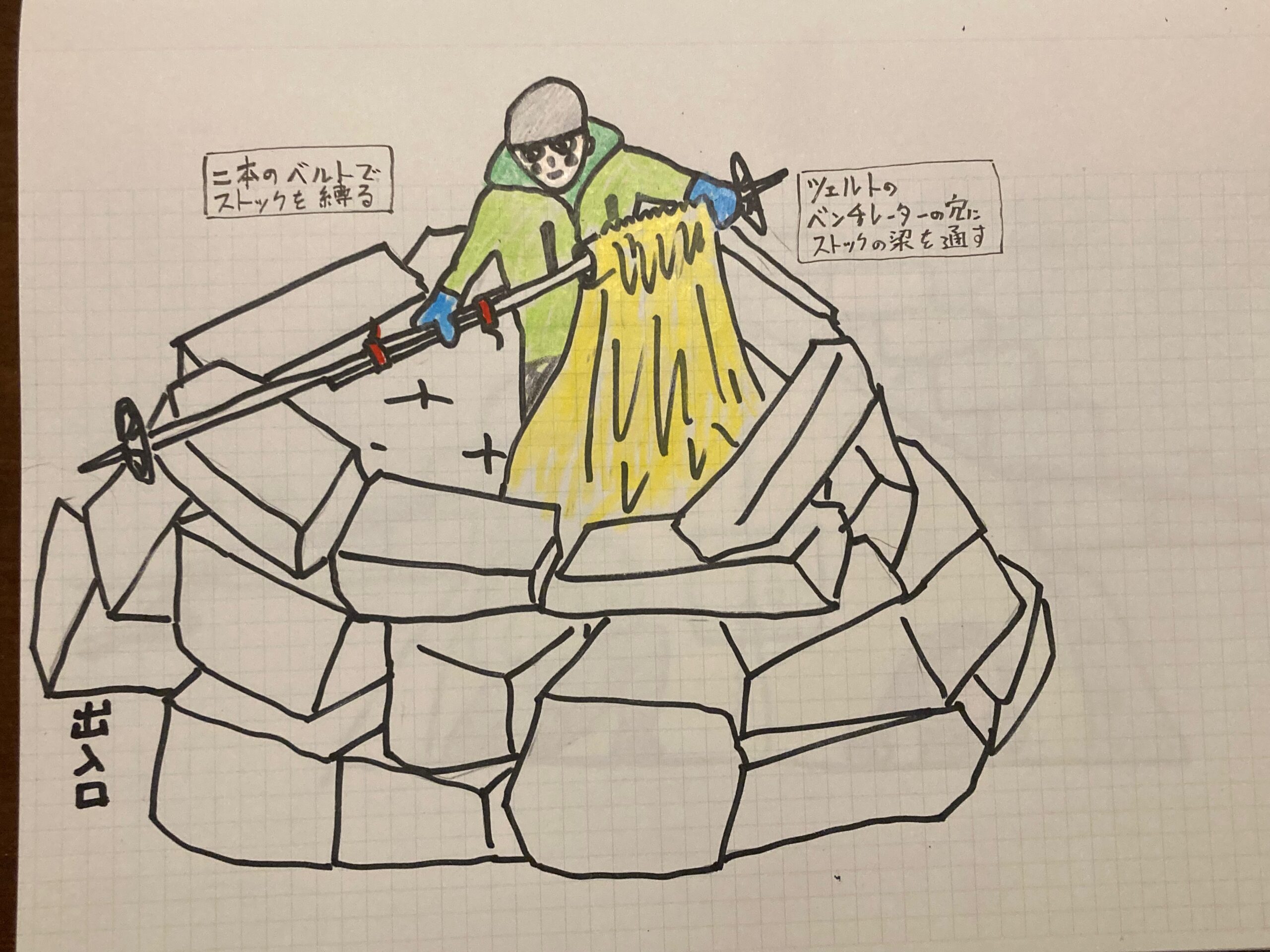


コメント